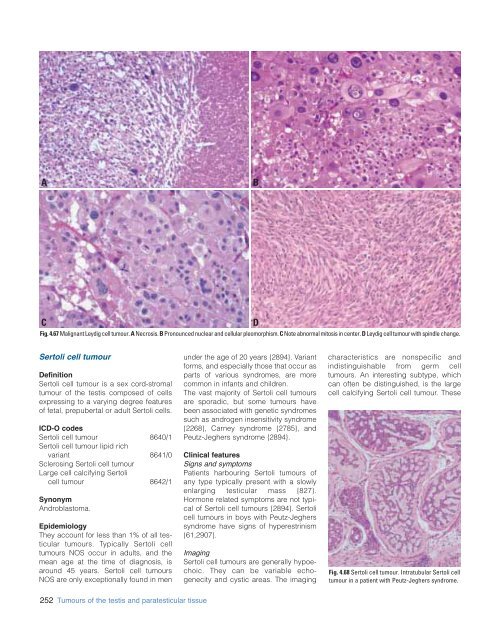CHAPTER X CHAPTER 4 - Cancer et environnement
CHAPTER X CHAPTER 4 - Cancer et environnement
CHAPTER X CHAPTER 4 - Cancer et environnement
Create successful ePaper yourself
Turn your PDF publications into a flip-book with our unique Google optimized e-Paper software.
A<br />
B<br />
C<br />
Fig. 4.67 Malignant Leydig cell tumour. A Necrosis. B Pronounced nuclear and cellular pleomorphism. C Note abnormal mitosis in center. D Leydig cell tumour with spindle change.<br />
D<br />
Sertoli cell tumour<br />
Definition<br />
Sertoli cell tumour is a sex cord-stromal<br />
tumour of the testis composed of cells<br />
expressing to a varying degree features<br />
of f<strong>et</strong>al, prepubertal or adult Sertoli cells.<br />
ICD-O codes<br />
Sertoli cell tumour 8640/1<br />
Sertoli cell tumour lipid rich<br />
variant 8641/0<br />
Sclerosing Sertoli cell tumour<br />
Large cell calcifying Sertoli<br />
cell tumour 8642/1<br />
Synonym<br />
Androblastoma.<br />
Epidemiology<br />
They account for less than 1% of all testicular<br />
tumours. Typically Sertoli cell<br />
tumours NOS occur in adults, and the<br />
mean age at the time of diagnosis, is<br />
around 45 years. Sertoli cell tumours<br />
NOS are only exceptionally found in men<br />
under the age of 20 years {2894}. Variant<br />
forms, and especially those that occur as<br />
parts of various syndromes, are more<br />
common in infants and children.<br />
The vast majority of Sertoli cell tumours<br />
are sporadic, but some tumours have<br />
been associated with gen<strong>et</strong>ic syndromes<br />
such as androgen insensitivity syndrome<br />
{2268}, Carney syndrome {2785}, and<br />
Peutz-Jeghers syndrome {2894}.<br />
Clinical features<br />
Signs and symptoms<br />
Patients harbouring Sertoli tumours of<br />
any type typically present with a slowly<br />
enlarging testicular mass {827}.<br />
Hormone related symptoms are not typical<br />
of Sertoli cell tumours {2894}. Sertoli<br />
cell tumours in boys with Peutz-Jeghers<br />
syndrome have signs of hyperestrinism<br />
{61,2907}.<br />
Imaging<br />
Sertoli cell tumours are generally hypoechoic.<br />
They can be variable echogenecity<br />
and cystic areas. The imaging<br />
characteristics are nonspecific and<br />
indistinguishable from germ cell<br />
tumours. An interesting subtype, which<br />
can often be distinguished, is the large<br />
cell calcifying Sertoli cell tumour. These<br />
Fig. 4.68 Sertoli cell tumour. Intratubular Sertoli cell<br />
tumour in a patient with Peutz-Jeghers syndrome.<br />
252 Tumours of the testis and paratesticular tissue
















